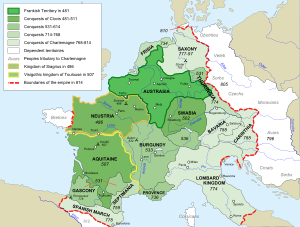Frisian–Frankish wars
| Frisian-Frankish War | |||||||
|---|---|---|---|---|---|---|---|
 Map of the Frankish Empire from 481 to 814 |
|||||||
|
|||||||
| Belligerents | |||||||
| Frankish kingdom | Frisian kingdom | ||||||
The Frisian–Frankish wars were a series of conflicts between the Frankish Empire and the Frisian kingdom in the 7th and 8th centuries.
The wars were mainly about control of the Rhine delta. But after the death of the Frisian king Redbad, the Franks gained the upper hand. In 734 at the Battle of the Boarn the Frisians were defeated and the Franks annexed the Frisian lands between the Vlie and the Lauwers. Only the Frisians east of the Lauwers remained independent. In 772 they lost their independence as well. The wars ended with the last uprising of the Frisians in 793 and the pacification of the Frisians by Charlemagne.
The displacements of peoples during the Migration Period resulted in the Frisian settlements in the north and the west of the Low Countries the Saxons in the east, the Warnen at the mouth of the Rhine and the Franks further south around the Scheldt. There, under the leadership of their Merovingian kings, they had an important role in the politics in northern Gaul.
The Frisians consisted of loosely bonded tribes centered on war bands but without great power. In the second half of the 7th century the Frisian kingdom reached its maximum geographic development. The Frisian kings became interested in former Frankish lands; under the leadership of the predecessors of Aldgisl they expanded their power to the heart of the Low Countries. The presence of the Warnen at the mouth of the Rhine remains unclear, but it appears they were likely crushed between the Frisians and Franks.
Though the Merovingian king of the Franks Chilperic I (561-584) is mentioned in Frankish sources as the "terror of the Frisians and the Suebi," there is evidence that around 600 the Frisians were successful in a war led by their king Audulf. This allowed the Frisians to expand further south.
...
Wikipedia
